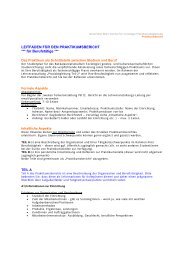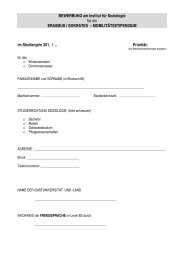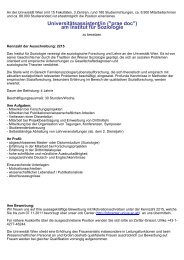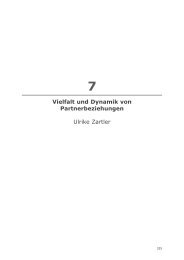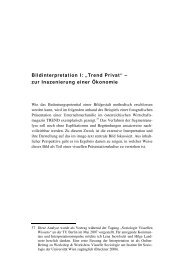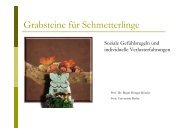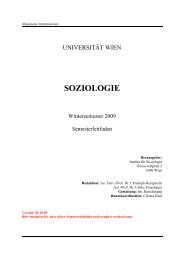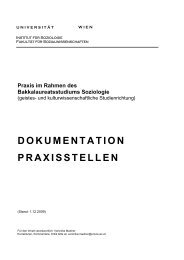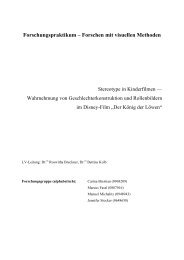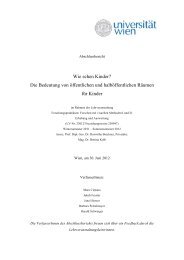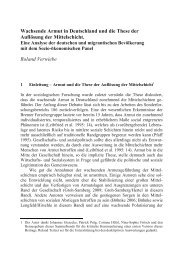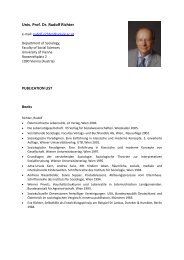Why do Europeans Migrate to Berlin? SocialStructural Differences ...
Why do Europeans Migrate to Berlin? SocialStructural Differences ...
Why do Europeans Migrate to Berlin? SocialStructural Differences ...
You also want an ePaper? Increase the reach of your titles
YUMPU automatically turns print PDFs into web optimized ePapers that Google loves.
24 Verwiebe<br />
10. A further differentiation of solely cultural reasons for migration (n = 95)<br />
and solely institutional reasons (n = 91), or even a differentiation of different<br />
aspects of the institutional fac<strong>to</strong>r (e.g. Erasmus, Socrates, Schengen<br />
rules, Maastricht Treaty) was not possible because of the number of cases<br />
available for study. In principle, this would be an interesting and promising<br />
contribution <strong>to</strong> the research. However, the multinomial regression could not<br />
produce meaningful results with a more differentiated dependent variable<br />
(the Hesse-matrix start <strong>to</strong> included unexpected singularities). The integration<br />
of cultural and institutionally-based reasons for migration can be justified<br />
from a content-related angle as well, because a very broad majority of those<br />
respondents with institutional reasons were migrating on the base of the<br />
Erasmus programme, which at its core is an educational and cultural programme<br />
[for tentative results on solely institutional reasons see footnote 12].<br />
11. The statistics software SPSS 15.0 was used for all analyses.<br />
12. Tentative results (<strong>to</strong> be interpreted with caution) for solely institutional reasons<br />
indicate a higher likelihood of institutional reasons for migration<br />
amongst the following groups: the group aged between 21 and 29, respondents<br />
who migrated <strong>to</strong> <strong>Berlin</strong> in 1994 and later, Polish respondents, respondents<br />
who already held a B.A. or a M.A. degree in their home countries.<br />
13. A collapsed five-ladder Erikson-Goldthorpe class scheme (Erikson and<br />
Goldthorpe 1992b) was the basis for the ‘‘dummy’’ class variable that was<br />
used. Due <strong>to</strong> data limitations further differentiations were not possible.<br />
14. Due <strong>to</strong> space limitations and for the sake of better readability, only significant<br />
interaction effects are reported. The complete tables can be obtained<br />
from the author on request.<br />
REFERENCES<br />
Amt fu¨ r Statistik <strong>Berlin</strong>-Brandenburg<br />
2008 Statistischer Bericht: melderechtlich registrierte Ausla¨nder im Land<br />
<strong>Berlin</strong> am 30. Juni 2008, Amt fu¨ r Statistik <strong>Berlin</strong>-Brandenburg,<br />
Potsdam.<br />
Bach, M.<br />
2005 ‘‘The enlargement crisis of the European Union’’. in M. Bach,<br />
et al (Eds.), Europe in Motion. Social Dynamics and Political Institutions<br />
in an Enlarging Europe, Edition Sigma, <strong>Berlin</strong>: 11–28.<br />
Bade, K. J.<br />
1987 Population, Labour and Migration in 19th and 20th Century<br />
Germany, Berg, Leaming<strong>to</strong>n.<br />
Baganha, M.I., and H. Entzinger<br />
2004 ‘‘The political economy of migration in an integrating Europe’’,<br />
IMIS-Beitra¨ge, 25: 7–19.<br />
Beavers<strong>to</strong>ck, J.V.<br />
2005 ‘‘Transnational elites in the city. British highly-skilled intercompany<br />
transferees in New York City’s financial district’’, Journal<br />
of Ethnic and Migration Studies, 31(2): 245–268.<br />
Ó 2011 The Author<br />
International Migration Ó 2011 IOM





